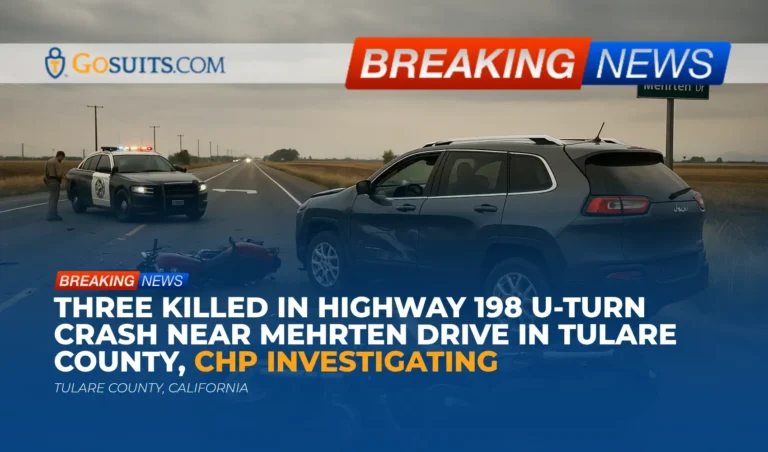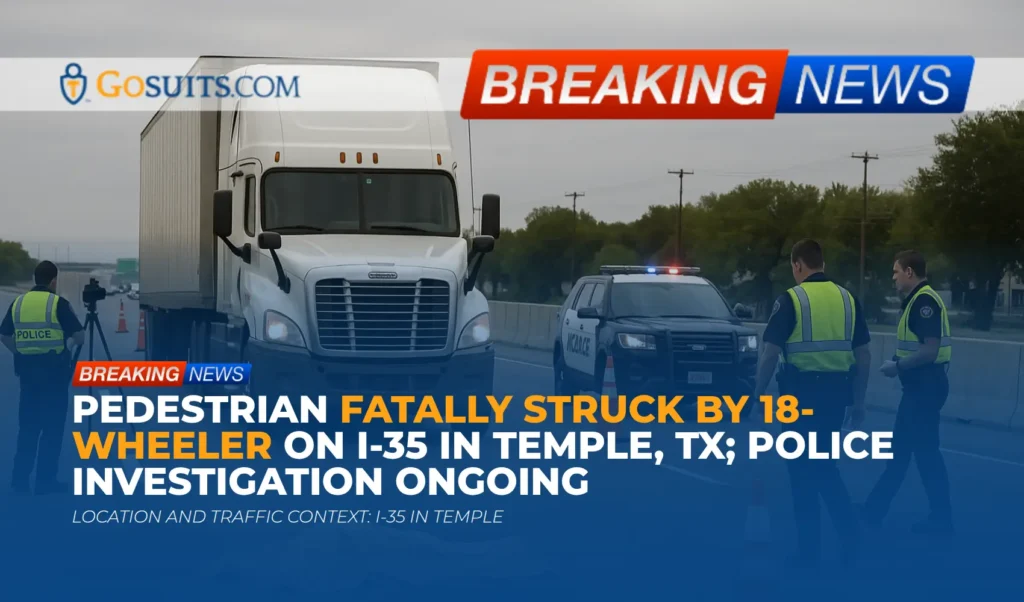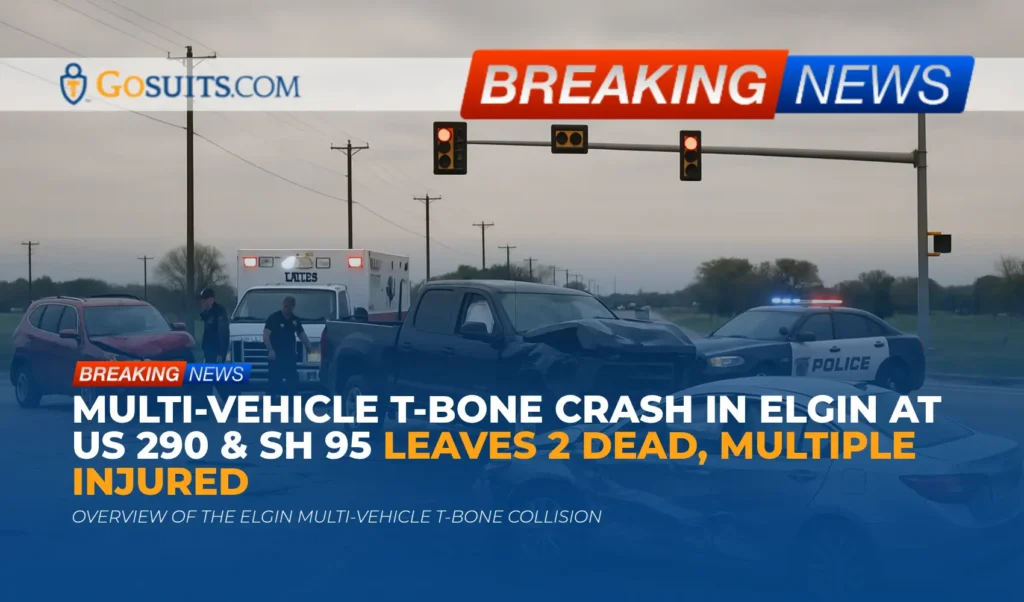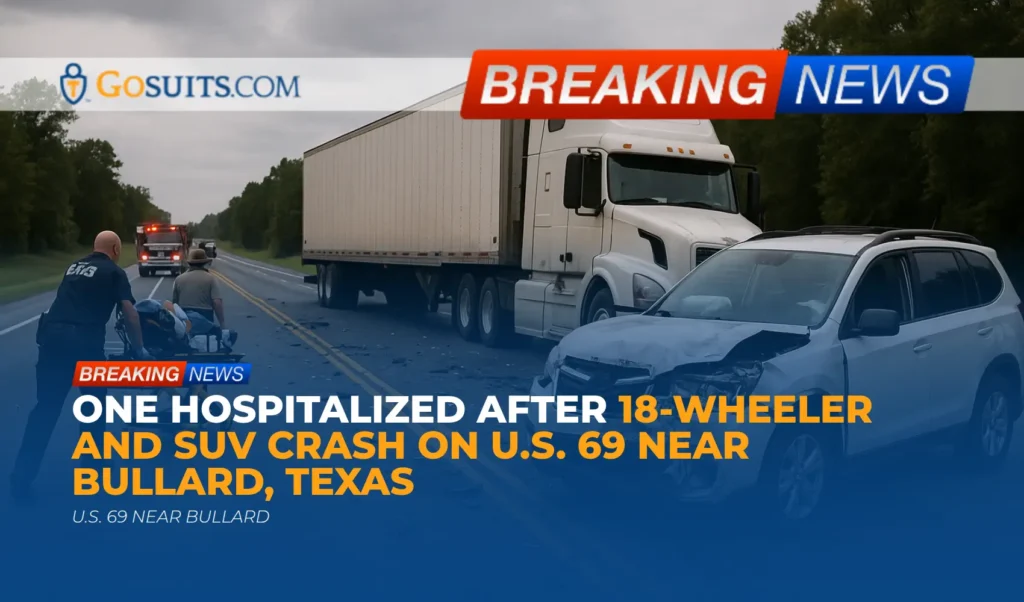- What We Know About the Tulare County Highway 198 Crash
- Location, Roadway, and Timing
- Status of the Investigation and Typical Steps Authorities Take
- Why U-turn Collisions Are Especially Dangerous for Motorcyclists
- Legal Rights After a Fatal Motorcycle Collision in California
- Insurance Considerations and Common Pitfalls
- Evidence to Preserve and How to Obtain Key Official Records
- Who to Contact in Tulare County for Reports and Assistance
- Safety and Prevention Insights for the Community
- Data Snapshot: Motorcycle Crash Risk
- Commentary from Gosuits Tulare County, California Personal Injury Attorney
- Actions That Should Not Be Delayed
What We Know About the Tulare County Highway 198 Crash
According to preliminary information reported by local media citing the California Highway Patrol, three people lost their lives in a crash on Highway 198 in Tulare County. Investigators indicated a 25-year-old man driving a Jeep Cherokee westbound on Highway 198 executed a sudden U-turn into oncoming traffic. Two motorcyclists, reported to be ages 61 and 35, struck the side of the Jeep. Both motorcyclists were ejected due to the force of the impact. Tragically, all three drivers were pronounced deceased at the scene. Authorities are investigating whether alcohol or drugs played a role. The names of those who died have not been publicly released as of the report.
At this stage, these details remain subject to official investigation. Families and the community often need clarity not only on what happened but also on the steps to find reliable information and protect their rights. The sections below explain how fatal crash investigations proceed, what records exist and how to request them, and general legal frameworks that may apply in a wrongful death scenario after a motorcycle crash in California.
Location, Roadway, and Timing
Authorities described the crash location as Highway 198 east of Mehrten Drive in Tulare County, California. Highway 198 is a key east-west corridor in the region, with portions that are multi-lane and potentially divided, and with changing speed limits depending on the zone and roadway design. The collision reportedly occurred on a Sunday; a precise time was not included in the initial report summarized here.
Because lighting, traffic volume, and sight distance can vary by time of day and segment of Highway 198, investigators typically examine weather, roadway configuration, signage, lane markings, and visibility. The California Department of Transportation (Caltrans) maintains information about highway conditions and projects; for questions about roadway design or maintenance in this area, Caltrans District 6 is the responsible district for Tulare County. See Caltrans District 6’s information at dot.ca.gov/caltrans-near-me/district-6.
Status of the Investigation and Typical Steps Authorities Take
The California Highway Patrol (CHP) ordinarily leads the investigation for fatal collisions on state highways. For crashes involving death, CHP may deploy specialized investigators or, in some cases, a Multidisciplinary Accident Investigation Team (MAIT) to analyze vehicle dynamics, evidence on the roadway, speed estimations, line-of-sight, and other technical factors. Learn more about MAIT on the CHP site at chp.ca.gov/traffic-concerns/mait.
A standard investigative process often includes:
- Scene documentation: Measuring skid marks, gouge marks, debris fields, final rest positions, and roadway conditions; photographing the scene and vehicles.
- Witness statements: Interviewing drivers who stopped, nearby residents, or riders in the area who observed the lead-up or aftermath.
- Vehicle inspections: Examining collision damage, lights, tires, and potential mechanical issues; downloading electronic data recorders where available.
- Toxicology: Coordinating with the coroner’s office for postmortem toxicology to assess possible alcohol or drug involvement.
- Report drafting: Creating a collision report with a diagram and narrative; in some cases, a supplemental MAIT report provides technical analysis.
Families can request the official CHP collision report once it is available, usually after the initial investigative steps are completed. CHP explains eligibility and how to request traffic collision reports at chp.ca.gov/programs-services/programs/traffic-accident-reports.
Why U-turn Collisions Are Especially Dangerous for Motorcyclists
Riders are more exposed than vehicle occupants and often have less time and distance to respond when a larger vehicle enters their path unexpectedly. A sudden U-turn across lanes can create a near-instant perpendicular hazard. If a motorcycle’s right-of-way is compromised, a side impact to a turning vehicle can result in a rider striking the vehicle or being ejected.
California’s traffic rules require that any turn, including a U-turn, be made only when safe and lawful given lane markings, location, and visibility. For example, California law generally prohibits driving to the left of, or crossing, double parallel solid lines except in limited circumstances, see California Vehicle Code section 21460 at leginfo.legislature.ca.gov. U-turns also have restrictions related to business districts, intersections, and visibility. See Vehicle Code sections 22102, 22103, and 22105 at:
- leginfo.legislature.ca.gov (VC 22102)
- leginfo.legislature.ca.gov (VC 22103)
- leginfo.legislature.ca.gov (VC 22105)
This discussion is general. Whether any specific statute applies in a given crash depends on the precise roadway markings, location type, and the investigative findings by CHP.
Legal Rights After a Fatal Motorcycle Collision in California
Who may bring a wrongful death claim
When a fatal collision occurs in California, certain family members may bring a wrongful death action for their losses. Eligibility is defined by statute. See California Code of Civil Procedure section 377.60 at leginfo.legislature.ca.gov. A related “survival” action may be brought on behalf of the decedent’s estate to recover losses the decedent suffered before death, as set out in CCP section 377.30 at leginfo.legislature.ca.gov.
Time limits
Strict time limits apply. In most personal injury and wrongful death matters in California, the general statute of limitations is two years from the date of injury or death. See CCP section 335.1 at leginfo.legislature.ca.gov. If any public entity may bear responsibility for a dangerous condition of public property, additional claim presentation requirements often apply within six months under the Government Claims Act. See Government Code section 911.2 at leginfo.legislature.ca.gov. The correct deadline depends on the facts of the case and the parties involved.
Potentially responsible parties
- Turning driver: If a driver executes an unsafe or unlawful U-turn that intrudes on the right-of-way of approaching traffic, civil liability may be implicated.
- Vehicle owner: In some circumstances, a vehicle owner who permitted another to drive may face responsibility under permissive use theories.
- Employer: If the driver was acting in the course of employment, vicarious liability could be considered.
- Public entities: If roadway design, sight obstructions, or missing signage contributed, a claim could be evaluated under California’s dangerous condition of public property laws. These claims require careful analysis and strict pre-lawsuit claim procedures.
Comparative fault in California
California applies comparative fault principles, meaning responsibility for damages can be allocated among parties based on their percentage of fault. The concept appears in the state’s civil jury instructions. See Judicial Council of California Civil Jury Instructions (CACI) No. 405 in the official CACI publication at courts.ca.gov. Allocation depends on the evidence and the findings in each case.
Motorcycle-specific considerations
- Helmet requirements: California requires compliant motorcycle helmets for riders and passengers. See Vehicle Code section 27803 at leginfo.legislature.ca.gov. Allegations about equipment should be evaluated carefully and in context with the crash dynamics.
- Visibility and lane positioning: Investigations often consider conspicuity factors, lane position, and speed. Conclusions should be based on measured evidence, not assumptions.
Insurance Considerations and Common Pitfalls
Insurance issues typically arise quickly after a fatal crash. Several types of coverage may be relevant:
- Liability insurance: The turning driver’s auto liability policy, if any, is often central in claims brought by families of those who died.
- Uninsured/Underinsured Motorist (UM/UIM): If a rider carried UM/UIM coverage and the at-fault party is uninsured or underinsured, these benefits may help. Policies vary in how wrongful death and survival damages are handled.
- Medical payments: Some policies include MedPay. In fatal collisions, MedPay may contribute to immediate medical or ambulance expenses where applicable.
- Property damage: Policies may cover motorcycle or vehicle loss, towing, and storage.
Insurance carriers often seek early statements. Before initiating any insurance claim or providing a recorded statement, it is prudent to speak with a qualified attorney in a free consultation to understand rights and obligations. Statements can be used to limit recovery or dispute liability later.
Settlement discussions may begin while investigations are ongoing. It is important to ensure the collision report, relevant witness statements, vehicle inspections, and coroner findings are obtained and reviewed so that decisions are informed by the best available facts.
Evidence to Preserve and How to Obtain Key Official Records
Timely preservation of evidence improves clarity and can prevent the loss of crucial information. The following records and steps are commonly relevant after a fatal highway crash in California:

CHP collision report and diagrams
The primary crash report typically includes a narrative, scene diagram, involved parties, and any citations noted by officers. Eligible requesters can apply for the report through CHP’s process described at chp.ca.gov/programs-services/programs/traffic-accident-reports. If a MAIT investigation is conducted, a more technical report may also exist, though release rules can differ.
Coroner and autopsy records
In Tulare County, the Sheriff’s Office also serves as the Coroner. Coroner records may include the cause and manner of death, autopsy reports, and toxicology results when performed. Families can find contact information and procedures on the Tulare County Sheriff-Coroner website at tularecounty.ca.gov/sheriff. Access to certain records can depend on next-of-kin status and the stage of the investigation.
Death certificates
Certified copies of death certificates are issued through California’s vital records system. The California Department of Public Health explains how to obtain certified copies at cdph.ca.gov. These certificates are often necessary for estate and benefits matters.
Toxicology results
If toxicology tests were ordered, results are typically coordinated through the coroner’s office. Turnaround times vary by laboratory workload and testing complexity. Coroner staff can advise next of kin about availability and release procedures. See the Tulare County Sheriff-Coroner page at tularecounty.ca.gov/sheriff.
911 recordings, dispatch logs, and body camera footage
Depending on the agencies involved, audio recordings, computer-aided dispatch logs, and certain recordings may be subject to public records laws, with privacy and investigatory exemptions. The California Attorney General provides guidance on the California Public Records Act at oag.ca.gov/transparentgov/cpra. Requests typically must identify the incident date, location, and agency.
Roadway maintenance and design information
If roadway design or maintenance is at issue, publicly available Caltrans materials or project records may be relevant. Caltrans District 6 serves Tulare County. See dot.ca.gov/caltrans-near-me/district-6 for district contacts and information about the state routes it maintains. Consult Government Code section 911.2 for public entity claim deadlines at leginfo.legislature.ca.gov.
Motorcycle and vehicle inspections
Post-crash inspections and preservation of the vehicles are often critical. When possible, avoid authorizing destructive inspections without documenting both vehicles. Insurance storage yards may have procedures that set limits on how long a vehicle is kept. Prompt arrangements reduce the chance of spoliation or disposal before a thorough review.
Who to Contact in Tulare County for Reports and Assistance
The following official agencies are typical points of contact. Always confirm eligibility and procedures with the agency before submitting requests:
- California Highway Patrol (CHP) – Collision Reports: Instructions and forms for obtaining traffic collision reports are published at chp.ca.gov/programs-services/programs/traffic-accident-reports. To locate the local office serving the Highway 198 area near Mehrten Drive, use CHP’s “Find an Office” tool at chp.ca.gov/find-an-office.
- Tulare County Sheriff-Coroner: For coroner case status, autopsy information, and next-of-kin guidance, visit tularecounty.ca.gov/sheriff.
- California Department of Public Health – Vital Records: For certified death certificates, see cdph.ca.gov.
- California Victim Compensation Board (CalVCB): Information on victim compensation for eligible crime-related expenses is available at victims.ca.gov. Eligibility depends on the nature of the incident and applicable statutes.
- Caltrans District 6: For roadway-related inquiries concerning state routes in Tulare County, see dot.ca.gov/caltrans-near-me/district-6.
If you are unsure which CHP office handled the scene, the “Find an Office” tool can be searched by county or city. Agency staff can confirm report availability and what documentation you need to demonstrate eligibility for release.
Safety and Prevention Insights for the Community
Motorcycle safety is a shared responsibility. Drivers must check mirrors and blind spots, scan for smaller profiles, and only execute U-turns or other maneuvers when lawful and safe. Riders benefit from high-visibility gear, lane positioning that maximizes sightlines, and training that emphasizes scanning and escape paths. California’s Office of Traffic Safety highlights rider safety considerations at ots.ca.gov/roadway-safety/motorcyclist-safety.
National research underscores the disproportionate risk borne by riders. The National Highway Traffic Safety Administration (NHTSA) reports that motorcyclists face a markedly higher fatality rate per mile traveled than passenger vehicle occupants. See NHTSA’s motorcycle safety overview at nhtsa.gov/road-safety/motorcycles.
When the community absorbs the lessons of a tragic crash, near-term steps such as extra caution near turns, avoiding sudden roadway entries, and respecting lane markings can reduce risk. Public agencies also use crash data to assess whether engineering measures, signage, or markings could improve safety at specific locations.
Data Snapshot: Motorcycle Crash Risk
The figures below provide a broad national snapshot. Risk can vary by state, roadway, and traffic mix, but the national perspective helps explain why left-turn and U-turn conflicts are so dangerous for riders. Sources are noted beneath the table.
|
Indicator |
United States |
Notes |
|
Motorcyclist fatalities (2021) |
5,932 |
Highest in decades |
|
Relative fatality risk per vehicle miles traveled (motorcyclists vs. passenger vehicle occupants) |
Several dozen times higher |
NHTSA reports markedly higher risk for riders per mile traveled |
|
Primary crash types contributing to rider deaths |
Multi-vehicle conflicts, including turning vehicles |
Visibility and right-of-way violations common factors |
Source: NHTSA motorcycle safety overview at nhtsa.gov/road-safety/motorcycles.

Commentary from Gosuits Tulare County, California Personal Injury Attorney
Our hearts are with the families and everyone affected by this devastating crash on Highway 198. This discussion is offered for general information and education. In the aftermath of sudden loss, it can be difficult to balance the need for answers with the many practical steps that follow. We hope the information here helps orient those seeking clarity.
From a civil injury perspective, a sudden U-turn into the path of oncoming motorcycles raises serious concerns about right-of-way and safe turning rules. California law requires that turns be made only when it is safe, and roadway markings and location-specific restrictions must be respected. Whether a specific violation occurred is a matter for investigators, and any civil evaluation should be grounded in the official collision report, scene evidence, and coroner findings. It is also appropriate to ask whether roadway design, sightlines, or markings played any role, which can be assessed with the help of public records and, where warranted, expert analysis.
In our experience, insurance companies move quickly after serious collisions. Their goal is to limit exposure, often by taking statements, framing liability issues early, or pushing for quick resolutions before all evidence is gathered. Large corporations and insurers understand procedure, deadlines, and the nuances of comparative fault, and they may use that knowledge gap to their advantage. Families deserve time and information before making decisions that could affect their rights. A no-cost consultation with a seasoned attorney can help clarify the path forward, identify deadlines, and ensure that critical evidence and records are preserved.
Actions That Should Not Be Delayed
- Identify the investigating office and request the report as soon as eligible: CHP collision reports and any supplemental materials inform nearly every downstream decision. Early requests help avoid delays once the report is released.
- Secure vehicles and physical evidence before it is altered or destroyed: Tow yards, storage facilities, and insurers may move or dispose of vehicles on standard schedules. Prompt arrangements protect the ability to inspect and photograph critical components and damage patterns.
- Preserve potential video and digital records: Nearby businesses, private homes, or dashcams may have footage with short retention windows. Written preservation notices and timely outreach can make the difference between having video or not.
- Coordinate with the coroner for status updates on autopsy and toxicology: Understanding cause and manner of death and any toxicology findings often informs both closure and legal strategy. Ask about expected release procedures for next of kin.
- Document financial and practical impacts: Funeral costs, lost income, and household services are time-sensitive to track. Later, detailed documentation can help accurately describe losses if a claim is pursued.
- Consult with an attorney before contacting insurers: Initial statements can shape liability and damages arguments. Speaking with counsel in a free consultation first helps ensure communications are accurate and do not unintentionally narrow available claims.
- Calendar applicable deadlines: Standard statutes and any public entity claim deadlines can run quickly. Establishing a timeline and tracking dates reduces the risk of forfeiting claims due to late filings.
Additional Official Resources
- California Highway Patrol – Collision Reports: chp.ca.gov/programs-services/programs/traffic-accident-reports
- CHP Find an Office: chp.ca.gov/find-an-office
- Tulare County Sheriff-Coroner: tularecounty.ca.gov/sheriff
- California Department of Public Health – Vital Records: cdph.ca.gov
- Caltrans District 6: dot.ca.gov/caltrans-near-me/district-6
- California Victim Compensation Board (CalVCB): victims.ca.gov
- NHTSA – Motorcycles: nhtsa.gov/road-safety/motorcycles
- California Vehicle Code – Selected Sections: leginfo.legislature.ca.gov
- California Public Records Act Overview: oag.ca.gov/transparentgov/cpra






